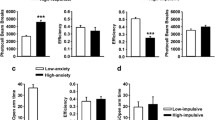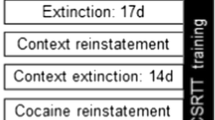Abstract
Rationale
The neural and psychological mechanisms underlying vulnerability to drug addiction are poorly understood. Although a number of animal models have been developed to investigate vulnerability to stimulant addiction, few have considered how vulnerability traits such as impulsivity predict hallmark features of heroin addiction including the escalation of drug intake and increased propensity for relapse following protracted abstinence.
Objective
The aim of this study was to investigate whether high impulsivity in rats predicts the propensity to escalate intravenous heroin self-administration and to relapse following an extended withdrawal period from heroin.
Methods
High (HI)- and low (LI)-impulsive rats, defined by the extent of premature responding on the 5-choice serial reaction time test (5-CSRTT), were catheterized and allowed to self-administer heroin (40 μg/100 μl/infusion). After 5 days of short access (1 h/day) to heroin, rats were then given extended (6 h/day) access to heroin for 18 consecutive days.
Results
High impulsivity predicted neither a greater tendency to acquire heroin SA nor an increased escalation of heroin self-administration. Moreover, high impulsivity was not associated with an increased propensity to relapse after protracted withdrawal from heroin. Nevertheless, marked inter-individual differences in the escalation of heroin self-administration were observed.
Conclusions
Although high impulsivity on the 5-CSRTT has been shown to predict loss of control over cocaine intake, this does not generalize to a loss of control over heroin self-administration. These findings suggest important distinctions in vulnerability mechanisms underlying cocaine and heroin addiction with trait-like impulsivity playing a role in stimulant but not opiate addiction.





Similar content being viewed by others
References
Ahmed SH, Koob G (1998) Transition from moderate to excessive drug intake: change in hedonic set point. Science 282:298–300
Ahmed SH, Koob G (1999) Long-lasting increase in the set point for cocaine self-administration after escalation in rats. Psychopharmacology (Berl) 146:303–312
Ahmed SH, Walker JR, Koob G (2000) Persistent increase in the motivation to take heroin in rats with a history of drug escalation. Neuropsychopharmacology 22:413–421
Anker JJ, Perry JL, Gliddon LA, Carroll ME (2009) Impulsivity predicts the escalation of cocaine self-administration in rats. Pharmacol Biochem Behav 93(3):343–348
APA (2000) Diagnostic and statistical manual of mental disorders. APA, Washington DC
Bari A, Dalley JW, Robbins TW (2008) The application of the 5-choice serial reaction time task for the assessment of visual attentional processes and impulse control in rats. Nat Protocol 3(5):759–767
Belin D, Everitt BJ (2008) Cocaine-Seeking Habits Depend upon Dopamine-Dependent Serial Connectivity Linking the Ventral with the Dorsal Striatum Neuron 57:432–441
Belin D, Mar AC, Dalley JW, Robbins TW, Everitt BJ (2008) High impulsivity predicts the switch to compulsive cocaine-taking. Science 320:1352–1355
Belin D, Balado E, Piazza PV, Deroche-Gamonet V (2009) Pattern of intake and drug craving predict the development of cocaine addiction-like behavior in rats. Biol Psychiatry 65:863–868
Billieux J, Vanderlinden M, Ceschi G (2007) Which dimensions of impulsivity are related to cigarette craving? Addict Behav 32:1189–1199
Bornovalova M, Daughters S, Hernandez G, Richards J, Lejuez C (2005a) Differences in impulsivity and risk-taking propensity between primary users of crack cocaine and primary users of heroin in a residential substance-use program. Exp Clin Psychopharmacol 13:311–318
Bornovalova MA, Lejuez CW, Daughters SB, Zachary Rosenthal M, Lynch TR (2005b) Impulsivity as a common process across borderline personality and substance use disorders. Clin Psychol Rev 25:790–812
Cardinal R, Pennicott DR, Lakmali C, Robbins TW, Everitt BJ (2001) Impulsive choice induced in rats by lesions of the nucleus accumbens core. Science 292:2499–2501
Clark L, Robbins TW, Ersche KD, Sahakian BJ (2006) Reflection impulsivity in current and former substance users. Biol Psychiatry 60:515–522
Coffey SF, Gudleski GD, Saladin ME, Brady KT (2003) Impulsivity and rapid discounting of delayed hypothetical rewards in cocaine-dependent individuals. Exp Clin Psychopharmacol 11:18–25
Dalley JW, Lääne K, Pena Y, Theobald D, Everitt BJ, Robbins TW (2005) Attentional and motivational deficits in rats withdrawn from intravenous self-administration of cocaine or heroin. Psychopharmacology 182:579–587
Dalley JW, Fryer T, Brichard L, Robinson E, Theobald D, Laane K, Pena Y, Murphy ER, Shah Y, Probst K, Abakumova I, Aigbirhio F, Richards H, Hong Y, Baron J, Everitt BJ, Robbins TW (2007) Nucleus accumbens D2/3 receptors predict trait impulsivity and cocaine reinforcement. Science 315:1267–1270
Deroche-Gamonet V, Belin D, Piazza P (2004) Evidence for addiction-like behavior in the rat. Science 305:1014–1017
Diergaarde L, Pattij T, Poortvliet I, Hogenboom F, Devries W, Schoffelmeer A, Devries T (2008) Impulsive choice and impulsive action predict vulnerability to distinct stages of nicotine seeking in rats. Biol Psychiatry 63:301–308
Diergaarde L, Pattij T, Nawijn L, Schoffelmeer ANM, De Vries TJ (2009) Trait impulsivity predicts escalation of sucrose seeking and hypersensitivity to sucrose-associated stimuli. Behav Neurosci 123:794–803
Eagle DM, Baunez C (2009) Is there an inhibitory-response-control system in the rat? Evidence from anatomical and pharmacological studies of behavioral inhibition. Neurosci Biobehav Rev 34(10):50–72
Economidou D, Pelloux Y, Robbins TW, Dalley JW, Everitt BJ (2009) High Impulsivity predicts relapse to cocaine-seeking after punishment-induced abstinence. Biol Psychiatry 65(10):851–856
Elkins IJ, McGue M, Iacono WG (2007) Prospective effects of attention-deficit/hyperactivity disorder, conduct disorder, and sex on adolescent substance use and abuse. Arch Gen Psychiatry 64:1145–1152
Ernst M, Luckenbaugh DA, Moolchan ET, Leff MK, Allen R, Eshel N, London ED, Kimes A (2006) Behavioral predictors of substance-use initiation in adolescents with and without attention-deficit/hyperactivity disorder. Pediatrics 117:2030–2039
Ersche K, Turton AJ, Pradhan S, Bullmore ET, Robbins TW (2010) Drug addiction endophenotypes: impulsive versus sensation-seeking personality types. Biological Psychiatry, in press
Evenden JL (1999) Varieties of impulsivity. Psychopharmacology 146:348–361
Everitt BJ, Belin D, Economidou D, Pelloux Y, Dalley JW, Robbins TW (2008) Neural mechanisms underlying the vulnerability to develop compulsive drug-seeking habits and addiction. Philos Trans R Soc Lond B Biol Sci 363:3125–3135
Fillmore MT, Rush CR (2002) Impaired inhibitory control of behavior in chronic cocaine users. Drug Alcohol Depend 66:265–273
Heil SH, Johnson MW, Higgins ST, Bickel WK (2006) Delay discounting in currently using and currently abstinent cocaine-dependent outpatients and non-drug-using matched controls. Addict Behav 31:1290–1294
Jentsch JD, Taylor JR (1999) Impulsivity resulting from frontostriatal dysfunction in drug abuse: implications for the control of behavior by reward-related stimuli. Psychopharmacology 146:373–390
Khantzian EJ (1989) Addiction: self-destruction or self-repair? J Subst Abuse Treat 6:75
Khantzian EJ (1991) Self-regulation factors in cocaine dependence–a clinical perspective. NIDA Res Monogr 110:211–226
Khantzian EJ (1997) The self-medication hypothesis of substance use disorders: a reconsideration and recent applications. Harv Rev Psychiatry 4:231–244
Khantzian EJ, Mack JE, Schatzberg AF (1974) Heroin use as an attempt to cope: clinical observations. Am J Psychiatry 131:160–164
Kieres AK, Hausknecht KA, Farrar AM, Acheson A, de Wit H, Richards JB (2004) Effects of morphine and naltrexone on impulsive decision making in rats. Psychopharmacology (Berl) 173:167–174
Kirby KN, Petry NM (2004) Heroin and cocaine abusers have higher discount rates for delayed rewards than alcoholics or non-drug-using controls. Addiction 99:461–471
Kirby KN, Petry NM, Bickel WK (1999) Heroin addicts have higher discount rates for delayed rewards than non-drug-using controls. J Exp Psychol Gen 128:78–87
Koob G, Le Moal M (2008) Addiction and the brain antireward system. Annu Rev Psychol 59:29–53
Kreek MJ, Nielsen D, Butelman E, Laforge K (2005) Genetic influences on impulsivity, risk taking, stress responsivity and vulnerability to drug abuse and addiction. Nat Neurosci 8:1450–1457
Lejuez CW, Bornovalova MA, Daughters SB, Curtin JJ (2005) Differences in impulsivity and sexual risk behavior among inner-city crack/cocaine users and heroin users. Drug Alcohol Depend 77:169–175
Lejuez CW, Paulson A, Daughters SB, Bornovalova MA, Zvolensky MJ (2006) The association between heroin use and anxiety sensitivity among inner-city individuals in residential drug use treatment. Behav Res Ther 44:667–677
Lejuez CW, Bornovalova MA, Reynolds EK, Daughters SB, Curtin JJ (2007) Risk factors in the relationship between gender and crack/cocaine. Exp Clin Psychopharmacol 15:165–175
Madden GJ, Petry NM, Badger GJ, Bickel WK (1997) Impulsive and self-control choices in opioid-dependent patients and non-drug-using control participants: drug and monetary rewards. Exp Clin Psychopharmacol 5:256–262
Mitchell JM, Tavares VC, Fields HL, D’Esposito M, Boettiger CA (2007) Endogenous opioid blockade and impulsive responding in alcoholics and healthy controls. Neuropsychopharmacology 32:439–449
Moeller FG, Barratt ES, Dougherty DM, Schmitz JM, Swann AC (2001) Psychiatric aspects of impulsivity. Am J Psychiatry 158:1783–1793
Nestler EJ (2005) Is there a common molecular pathway for addiction? Nat Neurosci 8:1445–1449
Olmstead MC, Ouagazzal AM, Kieffer BL (2009) Mu and delta opioid receptors oppositely regulate motor impulsivity in the signaled nose poke task. PLoS ONE 4:e4410
Ornstein TJ, Iddon JL, Baldacchino AM, Sahakian BJ, London M, Everitt BJ, Robbins TW (2000) Profiles of cognitive dysfunction in chronic amphetamine and heroin abusers. Neuropsychopharmacology 23:113–126
Pattij T, Schetters D, Janssen MCW, Wiskerke J, Schoffelmeer ANM (2009) Acute effects of morphine on distinct forms of impulsive behavior in rats. Psychopharmacology 205:489–502
Robbins TW (2002) The 5-choice serial reaction time task: behavioural pharmacology and functional neurochemistry. Psychopharmacology 163(3–4):362–380
Robinson ES, Eagle DM, Economidou D, Theobald DE, Mar AC, Murphy ER, Robbins TW, Dalley JW (2009) Behavioural characterisation of high impulsivity on the 5-choice serial reaction time task: specific deficits in ‘waiting’ versus ‘stopping’. Behav Brain Res 196:310–316
Schinka JA, Curtiss G, Mulloy JM (1994) Personality variables and self-medication in substance abuse. J Pers Assess 63:413–422
Verdejo-Garcia AJ, Bechara A, Recknor EC, Perez-Garcia M (2007a) Negative emotion-driven impulsivity predicts substance dependence problems. Drug Alcohol Depend 91(2–3):213–219
Verdejo-Garcia AJ, Perales JC, Perez-Garcia M (2007b) Cognitive impulsivity in cocaine and heroin polysubstance abusers. Addict Behav 32:950–966
Volkow ND, Fowler JS, Wang GJ, Hitzemann R (1993) Decreased dopamine D2 receptor availability is associated with reduced frontal metabolism in cocaine abusers. Synapse 14:169–177
Wang GJ, Volkow ND, Fowler JS, Logan J, Abumrad NN, Hitzemann RJ, Pappas NS, Pascani K (1997) Dopamine D2 receptor availability in opiate-dependent subjects before and after naloxone-precipitated withdrawal. Neuropsychopharmacology 16:174–182
Wilens TE (2007) The nature of the relationship between attention-deficit/hyperactivity disorder and substance use. J Clin Psychiatry 68(Suppl 11):4–8
Wise RA (1998) Drug-activation of brain reward pathways. Drug Alcohol Depend 51:13–22
Acknowledgments
This work was supported by United Kingdom Medical Research Council (MRC) grants to BJE (G9536855) and JWD (G0701500) and by a European Communities Sixth Framework Programme Grant (‘Imagen’ LSHM-CT-2007-037286) and was conducted within the MRC/Wellcome Trust Behavioural and Clinical Neuroscience Institute. DB is supported by an INSERM AVENIR grant. The authors would like to thank Dr. Yavin Shaham for the insightful discussions.
Disclosure/Conflicts of interest
TWR discloses consultancy for Cambridge Cognition, Pfizer, Eli Lilly Inc., Wyeth, GlaxoSmithKline and Roche and holds share options in Cambridge Cognition and Allon Therapeutics. RMcN, JWD, BJE and DB have no disclosures.
Author information
Authors and Affiliations
Corresponding author
Rights and permissions
About this article
Cite this article
McNamara, R., Dalley, J.W., Robbins, T.W. et al. Trait-like impulsivity does not predict escalation of heroin self-administration in the rat. Psychopharmacology 212, 453–464 (2010). https://doi.org/10.1007/s00213-010-1974-9
Received:
Accepted:
Published:
Issue Date:
DOI: https://doi.org/10.1007/s00213-010-1974-9




